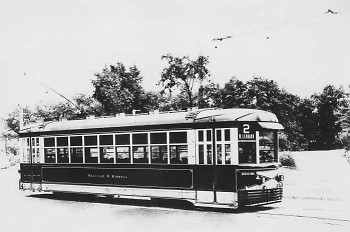This is part one of a five-part series that explores the effects of the automobile on Grand Rapids. In this part we explore how Grand Rapids lost the streetcar and started to develop around the automobile.
Wellington Avenue, off Eastern Avenue in SE Grand Rapids, is a physical remnant of the once mighty streetcar industry. There was a time when Grand Rapids was building up such an infrastructure that no Grand Rapidian had to walk more than a half mile to get to the final destination.
Since then, much has changed, and Bradford Snell has made a career researching the auto industry. In “Taken for a Ride,” a film by Jim Klein, he describes how in the early 1920s, only one out of ten Americans owned an automobile. The roads were designed so the streetcar had the middle of the road. Automobiles had to stay on the sides, making the street car the most efficient and economical way to get around the city.
Alfred Sloan, president of General Motors, was determined to eliminate street cars in order to corner the market and accommodate automobiles. He set out to replace all the street railways with buses because he believed no one would want to ride the buses and would buy GM automobiles. Sloan bought the largest bus operation company and the largest bus production company in the country. This began the departure from streetcars.
This change sweeping the nation affected Grand Rapids at the same time. In his article Public Policy, Franchises, and the End of the Street Railways in Grand Rapids, Michael Knopf detailed the streetcar's demise in GR and the developing downfalls that followed.
Grand Rapids started out with rail coaches in 1865. They were horse-drawn carriages that ran on tracks in the street. One company turned into a few companies located downtown. This was due to the fact that streetcars are most efficient in densely populated areas. In 1875, the first steam driven streetcar was introduced by the Reeds Lake Railroad Company. Reeds Lake was a popular summer destination in the small city of East Grand Rapids at the time. In 1884, the Valley City Cable Railway Company introduced the cable streetcar on their routes. The streetcar aided in the development of a small suburb called Eastown. Both Wolfgang’s Restaurant and the Hookah Lounge were originally streetcar barns.
The competition amongst the companies led to a consolidation, and in April 1900, they were incorporated into the Grand Rapids Railway Company (GRRC). By that time, all the cars were electric and improving in quality. Street railways ranked sixth largest industry in the nation. In 1920, the company was doing well financially and the public supported it. Louis DeLamarter, the general manager of GRRC, set high standards for streetcar quality. Large cities began to adapt to the standards and style of what they referred to in the country as the “Grand Rapids Electric Coach.”
In 1924, financial issues weighed on the company. On July 18, 1924 the car barns on Hall Street burned down, costing the company half a million dollars. In 1927, the Grand Rapids City Plan Department started a plan that envisioned a city with both auto and rail traffic serving 300,000 citizens by 1975.
In 1932, the city started operating its first bus route. That same year, the GRRC went into receivership. By 1934, the GR Committee on Public Services requested that all streetcars be replaced with buses. On August 23, 1935 the last streetcar made its final sendoff journey down Cherry Street. The city kept developing outward to accommodate the automobile.
I talked to Professor Lee Hardy about the post War years that saw great expansion of urban development. Hardy is a faculty member of the Department of Philosophy at Calvin College. He has also extensively researched the automobile and its effects on America.
Hardy believes that the planners of post-World War II America did not quite understand the future effects that designing America around the car would have. He discussed how the automobile and the housing industry surged after the war. People needed cars to get to their houses that were being built farther and farther outside the city. The auto industry employed millions of people in the 1950s and it kept America prosperous for a while.
He explained how a man named Lucius Clay was appointed by then-President Dwight D. Eisenhower to be part of a committee that studied how to implement a National Highway system and change America’s infrastructure to accommodate the car. Lucius Clay was also on the board of directors for General Motors at the time. According to Hardy, the car companies set the tone for development for the latter half of the 20th century.
This led to what is referred by urban theorist as Exurbia. The Exurbs are a ring of prosperous communities beyond the suburbs that are commuter towns for an urban area. Exurban commuting patterns consist of going edge to edge. Hardy informs me that across the nation the highest percentage of foreclosures are out on the edge. This is true for Grand Rapids metropolitan areas as well.
Hardy also points out that health studies have notice a strong correlation l between clinical obesity and living on the edge.
Urban sprawl has always made me uneasy, especially when I see a huge plot of land used for automobile parking. When researching online to become better informed on the subject, I found a good website source called Smarter Cities created by The Natural Resources Defense Council. According to the Web site, urban sprawl causes environmental damage, increased automobile traffic, and less walkability.
Smart Cities explains that sprawl consumes much more land per-capita than traditional urban developments because zoning laws often require that new developments are of low density. Low density buildings usually have fewer stories and are spaced farther apart, separated by lawns, roads and parking lots.
Lot sizes are larger and because more automobiles are used much more land is designated for parking. The impact of low density development in many communities is that developed or urbanized land is increasing at a faster rate than the population.
In Grand Rapids, we have a lot of space that is wasted for parking lots. We no longer have light rail. We do not have interconnected bicycle lanes in the city. We still accommodate the automobile more than any other form of transportation.
Hardy warned me that If we continue to be dependent on energy that is inefficient and expensive we could face a grim future 15 years from now. He feels we face the possibility of becoming a second or third rate country.
In part two, we will talk with Professor Lee Hardy of Calvin College to explore how the automobile has edged out civic and community life and has fostered an environment ripe for prejudices. Steve Faber of The Friends of GR Parks will talk about how his organization is trying to cultivate civic life by establishing green spaces.
Part I: The clash between the streetcar industry and automobile industry
Part II: The automobile's detrimental toll on community life
Part III: Ways to modify cities to accommodate alternative transportation
Part IV: Current efforts in Grand Rapids for strengthening alternative transportation
Part V: Did the car ever make sense?
The Rapidian, a program of the 501(c)3 nonprofit Community Media Center, relies on the community’s support to help cover the cost of training reporters and publishing content.
We need your help.
If each of our readers and content creators who values this community platform help support its creation and maintenance, The Rapidian can continue to educate and facilitate a conversation around issues for years to come.
Please support The Rapidian and make a contribution today.




Comments
Michael,
This is a terrifically informative and thoughtful piece of writing -- I'm really impressed. This is the kind of thing I want to read in the paper!
Great work.